Spherical polyhedron

In
The most familiar spherical polyhedron is the soccer ball, thought of as a spherical truncated icosahedron. The next most popular spherical polyhedron is the beach ball, thought of as a hosohedron.
Some "improper" polyhedra, such as hosohedra and their duals, dihedra, exist as spherical polyhedra, but their flat-faced analogs are degenerate. The example hexagonal beach ball, {2, 6}, is a hosohedron, and {6, 2} is its dual dihedron.
History
During the 10th Century, the Islamic scholar
The work of Buckminster Fuller on geodesic domes in the mid 20th century triggered a boom in the study of spherical polyhedra.[2] At roughly the same time, Coxeter used them to enumerate all but one of the uniform polyhedra, through the construction of kaleidoscopes (Wythoff construction).[3]
Examples
All regular polyhedra, semiregular polyhedra, and their duals can be projected onto the sphere as tilings:
| Schläfli symbol |
{p,q} | t{p,q} | r{p,q} | t{q,p} | {q,p} | rr{p,q} | tr{p,q} | sr{p,q} |
|---|---|---|---|---|---|---|---|---|
| Vertex config. |
pq | q.2p.2p | p.q.p.q | p.2q.2q | qp | q.4.p.4 | 4.2q.2p | 3.3.q.3.p |
| Tetrahedral symmetry (3 3 2) |
 33 |
 3.6.6 |
 3.3.3.3 |
 3.6.6 |
 33 |
 3.4.3.4 |
 4.6.6 |
 3.3.3.3.3 |
 V3.6.6 |
 V3.3.3.3 |
 V3.6.6 |
 V3.4.3.4 |
 V4.6.6 |
 V3.3.3.3.3 | |||
| Octahedral symmetry (4 3 2) |
 43 |
 3.8.8 |
 3.4.3.4 |
 4.6.6 |
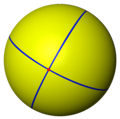 34 |
 3.4.4.4 |
 4.6.8 |
 3.3.3.3.4 |
 V3.8.8 |
 V3.4.3.4 |
 V4.6.6 |
 V3.4.4.4 |
 V4.6.8 |
 V3.3.3.3.4 | |||
| Icosahedral symmetry (5 3 2) |
 53 |
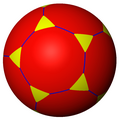 3.10.10 |
 3.5.3.5 |
 5.6.6 |
 35 |
 3.4.5.4 |
 4.6.10 |
 3.3.3.3.5 |
 V3.10.10 |
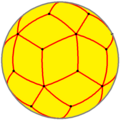 V3.5.3.5 |
 V5.6.6 |
 V3.4.5.4 |
 V4.6.10 |
 V3.3.3.3.5 | |||
| Dihedral example (p=6) (2 2 6) |
 62 |
 2.12.12 |
 2.6.2.6 |
 6.4.4 |
 26 |
 2.4.6.4 |
 4.4.12 |
 3.3.3.6 |

| n | 2 | 3 | 4 | 5 | 6 | 7 | ... |
|---|---|---|---|---|---|---|---|
| n-Prism (2 2 p) |
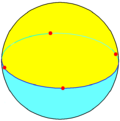
|

|

|

|

|
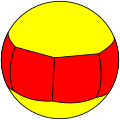
|
... |
| n-Bipyramid (2 2 p) |

|
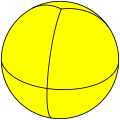
|
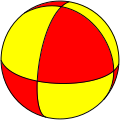
|

|

|

|
... |
| n-Antiprism | 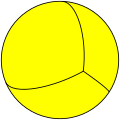
|

|

|

|

|

|
... |
| n-Trapezohedron | 
|

|

|

|
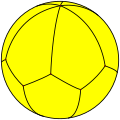
|

|
... |
Improper cases
Spherical tilings allow cases that polyhedra do not, namely
| Space | Spherical | Euclidean | |||||
|---|---|---|---|---|---|---|---|
| Tiling name |
Henagonal
hosohedron |
Digonal
hosohedron |
Trigonal
hosohedron |
Square
hosohedron |
Pentagonal
hosohedron |
... | Apeirogonal hosohedron |
| Tiling image |

|

|
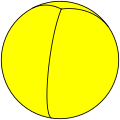
|

|

|
... | |
| Schläfli symbol |
{2,1} | {2,2} | {2,3} | {2,4} | {2,5} | ... | {2,∞} |
Coxeter
diagram |
... | ||||||
| Faces and edges |
1 | 2 | 3 | 4 | 5 | ... | ∞ |
| Vertices | 2 | 2 | 2 | 2 | 2 | ... | 2 |
| Vertex config. |
2 | 2.2 | 23 | 24 | 25 | ... | 2∞ |
| Space | Spherical | Euclidean | |||||
|---|---|---|---|---|---|---|---|
| Tiling name |
Monogonal
dihedron |
Digonal
dihedron |
Trigonal
dihedron |
Square
dihedron |
Pentagonal
dihedron |
... | Apeirogonal
dihedron |
| Tiling image |
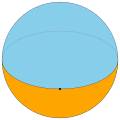
|

|

|

|

|
... | |
| Schläfli symbol |
{1,2} | {2,2} | {3,2} | {4,2} | {5,2} | ... | {∞,2} |
Coxeter
diagram |
... | ||||||
| Faces | 2 {1} | 2 {2} | 2 {3} | 2 {4} | 2 {5} | ... | 2 {∞} |
| Edges and vertices |
1 | 2 | 3 | 4 | 5 | ... | ∞ |
| Vertex config. |
1.1 | 2.2 | 3.3 | 4.4 | 5.5 | ... | ∞.∞ |
Relation to tilings of the projective plane
Spherical polyhedra having at least one
The best-known examples of projective polyhedra are the regular projective polyhedra, the quotients of the
- Hemi-cube, {4,3}/2
- Hemi-octahedron, {3,4}/2
- Hemi-dodecahedron, {5,3}/2
- Hemi-icosahedron, {3,5}/2
- Hemi-dihedron, {2p,2}/2, p≥1
- Hemi-hosohedron, {2,2p}/2, p≥1
See also
- Spherical geometry
- Spherical trigonometry
- Polyhedron
- Projective polyhedron
- Toroidal polyhedron
- Conway polyhedron notation
References
- .
- ISBN 978-1-4665-0430-1.
Buckminster Fuller's invention of the geodesic dome was the biggest stimulus for spherical subdivision research and development.
- JSTOR 91532.
- ISBN 0-521-81496-0.
- MR 0123930.


